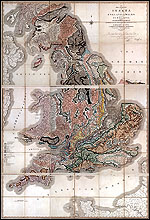Archives
Treasured map lures geologists to Buffalo
Buffalo library exhibit of map sparks interest at conference
By ELLEN GOLDBAUM
Contributing Editor
When UB planetary volcanologist Tracy Gregg mentioned at a recent geology conference that the Buffalo and Erie County Public Library was this fall exhibiting an original edition of the world's first geologic map, audience members were captivated.

"The Map that Changed the World" is on display in the Central Library branch of the Buffalo and Erie County Public Library.
COURTESY OF THE LIBRARY FOUNDATION, BECPL
"People were coming up to me afterward, asking when would be the best time to come to Buffalo to see the map and what hotel should they stay at," says Gregg, associate professor of geology. "I wouldn't be surprised if hundreds of geologists end up coming to Buffalo to see it."
This original, signed edition of the first series of geologic maps ever created is one of only two in the United States; the other is at the Library of Congress. The map is accompanied by a descriptive pamphlet series. There are just 43 known originals of the map in the world today.
Dubbed "The Map that Changed the World," by Simon Winchester in his popular 2001 book, the hand-tinted, 10-foot-by-six-foot map is on exhibit at the Central Library branch of the Buffalo and Erie County Public Library in downtown Buffalo.
"If geology were a religion, this map would be its bible," says Robert Jacobi, UB professor of geology.
But the map isn't only for geologists, stress Jacobi and Gregg.
"This map directly addresses the relationship of people to the natural world," says Gregg. "It directly influenced the industrial revolution, geology, biology and evolution. It forced people to think about our place in the universe."
Along with colleagues in the UB Department of Geology in the College of Arts and Sciences, Jacobi and Gregg will be doing their best to make that point this fall. In conjunction with the map's display, they will be leading a field trip to the Niagara Gorge on Saturday and participating in a semester-long lecture series at the library about geology at the local, global and planetary levels.
Children's events and exhibits with names like "Paper Bag Paleontology" and "Sedimentary Sandwiches" have been developed by graduate students in the Museum Studies Program in the Department of Art History, College of Arts and Sciences.
Information on the exhibit and these events for the public can be found at http://www.lfbuffalo.org/exhibitions/map/.
The hand-drawn map and pamphlets were created by canal surveyor William Smith in 1815 based on his travels throughout Great Britain on foot and on horseback.
Smith was the first to recognize and record the fact that rocks on the surface told the stories of the rocks and minerals that existed below the surface.
"Smith could 'read' the rocks on the surface," Gregg says. "He realized that it was not random, that earth's processes have a cycle and an order to them and that, for example, specific fossils are only in certain rocks."
That observation alone helped provide a foundation for Darwin's work later in the century.
Because the map provided a systematic method of linking what was under the ground with its surface, it played a major role in the industrial revolution, providing a method for the identification of valuable mineral deposits of coal, oil, iron ore and others.
"The map is a tool—a mechanism for communicating how you can peel back the layers of dirt, gravel and grass and see what's underneath," says Gregg. "So you can tell somebody, 'go to this spot on this street corner and this is what you will find.'"
Gregg notes that the geologic map is still the basic unit of conversation among geologists, and that nearly two centuries later, geologic maps are not all that different from Smith's.
The famous map found its way to Buffalo thanks to Chauncey Hamlin, who headed Buffalo's Museum of Science (then called the Buffalo Society of Natural Science) from 1920-48. During those years, he assembled a collection—called "The Milestones of Science"—of 196 first editions of manuscripts and letters of many of science's giants, including Copernicus, Galileo, Archimedes and Kepler. The William Smith map was among them.
In conjunction with the exhibit, several UB professors will give free public lectures in the West Room of the Central Library as part of the lecture series. Gregg spoke on planetary geology on Sept. 29. Charles E. Mitchell, SUNY Distinguished Teaching Professor and chair of the Department of Geology, spoke on "Maps, Rocks, and Theories of the World" on Oct. 13.
Other UB faculty members will deliver lectures from 6-8 p.m. on the following dates:
Oct. 27: "Faults and Earthquakes in New York State: Fault Recognition Through the Use of Advanced Mapping Techniques," Robert Jacobi, professor of geology.
Nov. 10: "Geological Map-Making: Then and Now," Marcus Bursik, professor of geology.
Nov. 17: "The Ice Sheet That Shaped Our Backyard," Jason Briner, assistant professor of geology.
More information on the lecture series is at http://www.lfbuffalo.org/exhibitions/map/l/.
